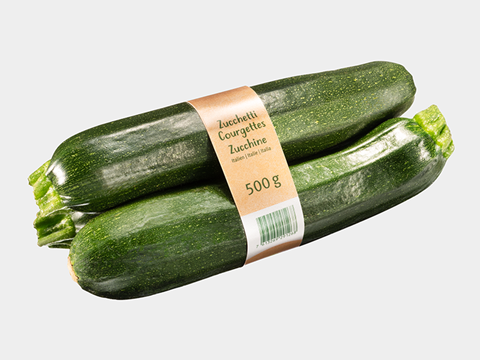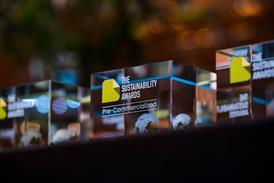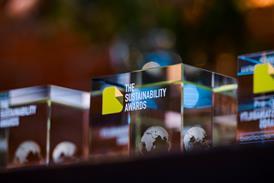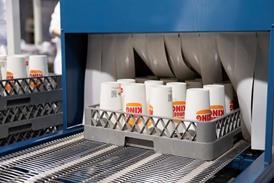
ATS-Tanner CEO Serge Tanner dives deeper into TruePaper, its recyclable paper band with a water-based bonding agent, as well as the sustainability credentials of its plastic solutions in this edition of our ‘In Conversation With…’ series.
Tell us about the background of ATS TruePaper.
In 2018, Germany began working on a new version of the Deutsche Verpackungsordnung (German Packaging Ordinance). Starting in 2028, all packaging must comply with the 95/5 rule—meaning packaging may contain no more than 5% non-target materials. For example, paper used for banding must not contain more than 5% plastic.
At that time, ATS-Tanner set out to develop an environmentally friendly, ultrasonic- and heat-sealable paper band with a water-based coating that would also be suitable for direct food contact.
In collaboration with ZHAW—a renowned Swiss university specializing in technical and engineering education—ATS-Tanner and its suppliers created a banding paper that meets these strict criteria, containing no more than 5% non-target components. This innovation became known as TruePaper.
TruePaper can be produced using virgin fibers, recycled fibers, or FSC-certified fibers. Any paper coated with the new water-based bonding agent can be transformed into TruePaper, offering high flexibility and reliability within the supply chain.
ATS-Tanner customers can choose to implement recycled paper into their TruePaper bands; where is the recyclate sourced from?
ATS-Tanner partners with Mondi to source recycled banding materials. Mondi manufactures these materials using renewable, responsibly sourced, and certified components, ensuring the recycled content is both ethically produced and safe for direct food contact.
This collaboration delivers a banding solution that is not only durable but also environmentally friendly. The materials are fully recyclable through standard paper recycling systems and fully meet the requirements of the new PPWR 2025/40/EU.
Together, ATS-Tanner and Mondi demonstrate a strong commitment to sustainability – reducing dependence on plastic packaging and advancing the use of recycled, recyclable materials in modern packaging solutions.
TruePaper also contains a water-based bonding agent. Could you tell us more about how it works and which sealing technologies it’s compatible with?
ATS-Tanner’s TruePaper utilizes a water-based bonding agent that enables the paper bands to be sealed using both ultrasonic and heat-sealing technologies. This coating is applied as a functional barrier on the paper, allowing for secure sealing without the need for traditional plastic coatings or synthetic adhesives.
The bonding agent ensures that the sealed joints have tensile shear strength comparable to conventional polypropylene-coated banding papers, providing durability and reliability in packaging applications.
Compatibility with both ultrasonic and heat-sealing methods offers flexibility in packaging operations. Ultrasonic sealing is particularly energy-efficient, consuming significantly less energy compared to traditional heat-sealing methods, thereby supporting sustainable packaging practices.
Moreover, the water-based coating contributes to the recyclability of TruePaper, aligning with environmental regulations such as the EU Directive 2019/904 on reducing the impact of certain plastic products on the environment. TruePaper can be recycled in the standard paper waste stream, making it an environmentally friendly alternative to plastic-based banding solutions.
ATS-Tanner offers banding films, too. What plastics do these bands use, and what environmental benefits can they provide?
ATS-Tanner offers a diverse range of banding films, among others made from PCR recyclable plastics, each tailored to meet specific application needs while supporting environmental sustainability.
Plastic Materials Used in ATS-Tanner Banding Films
- Polypropylene (PP), solid, cavitated or foamed wide range of specific banding film solutions
- High-Density Polyethylene (HDPE):
- Good transparency
- High impact resistance at low temperatures – good toughness
- PEH: Transparent, high-gloss, extremely strong and very tough
- Polylactic Acid (PLA):
- Highly transparent
- Very stiff
- Made from renewable sources
- Biodegradable but not compostable

Environmental Benefits:
Recyclability
All PP and HDPE films are made from mono-materials, ensuring they are 100% recyclable. A solution that fully meets the Design for Recycling strategy of the European Union.
Post-Consumer Recycled Content
Several film materials incorporate a minimum of 35% post-consumer recycled polypropylene, reducing reliance on virgin plastics and supporting circular economy initiatives. ATS’ next goal is to offer a PP film with 60% PCR content. The challenge is to establish a reliable supply chain with regular quality and specified raw material properties in sufficient and regular quantity.
Carbon-Neutral Production
The GHG impact of the manufacturing process for most of ATS-Tanner’s banding films is compensated by the purchase of CO2 certificates, contributing to reduced CO₂ emissions.
In addition the scope 3 CO2 emissions caused by the raw material can be reduced by switching to the PCR film solutions.
Energy-Efficient Sealing
The films are compatible with ultrasonic sealing technology, which consumes up to 98% less energy compared to traditional heat-sealing methods, further minimizing environmental impact.
Compliance with Environmental Regulations
The use of recycled content in transparent, foamed or opaque white films which contain 35% PCR content aligns with the new European PPWR regulation 2025/40/EU which is applicable for non sensitive packaging materials. Although we do not have a general EU plastic tax in place right now, only approaches in single countries like Spain, we can expect binding fees on unrecycled plastic packaging to start by 2028 at the latest.
For sensitive packaging like food or medical equipment, the PPWR sets a PCR quote of 10% by 2030. This can be achieved via chemical recycling or bio circular material solutions with mass balancing and ISCC+ certification.
By offering a variety of recyclable and biodegradable banding films, ATS-Tanner enables businesses to choose packaging solutions that align with their sustainability goals without compromising on performance or quality.
What about the low-migration, organoleptically neutral inks used in ATS-Tanner’s printed bands? Have any tests or certifications been completed to back up its food safety contact?
Yes, ATS-Tanner’s printed bands are certified for safe use in food packaging, supported by rigorous testing and internationally recognized certifications.
Food Safety Certifications and Compliance
- BRCGS Packaging Materials Global Standard (Grade AA): ATS-Tanner’s printing facility holds a Grade AA certification under the BRCGS Packaging Materials Global Standard, one of the highest hygiene and safety benchmarks in the packaging industry.
- FSSC 22000 Certification: All material suppliers for ATS-Tanner are certified according to FSSC 22000, ensuring adherence to stringent food safety management systems.
- FDA Compliance: The raw materials used in ATS-Tanner’s printed bands comply with U.S. FDA regulations, affirming their suitability for direct food contact.
Use of Low-Migration, Organoleptically Neutral Inks
ATS-Tanner utilizes low-migration, organoleptically neutral inks in their printed bands. These inks are specifically designed to prevent the transfer of substances into food products, ensuring that the taste and smell of the food remain unaffected. This makes them ideal for both primary and secondary food packaging applications.
Regulatory Compliance
The inks and materials used in ATS-Tanner’s printed bands meet various international food safety regulations, including:
- EU Regulation (EC) No 1935/2004: Ensures that materials intended to come into contact with food do not release harmful substances and requires specific test.
The banding films are in compliance with the restrictions of regulation 10/2011/EG ensuring that specific migration limits (SML) are not exceeded. - Swiss Ordinance SR 817.023.21: Specifies permitted substances and migration limits for food-contact materials, including printing inks.
- FDA 21 CFR: Governs the use of substances in food-contact materials in the United States.
By adhering to these regulations and certifications, ATS-Tanner ensures that their printed bands are safe for use in food packaging, maintaining product integrity and consumer safety.
Has ATS-Tanner faced any challenges in the balance between functionality, food safety, and recyclability?
Yes, ATS-Tanner has faced challenges in balancing functionality, food safety, and recyclability in its banding solutions. One key issue is that mechanical post-consumer recycled (PCR) material is currently not approved for direct food contact, as its origin cannot be reliably verified.
The alternative is to use sustainable materials from the chemical recycling stream or bio-circular materials that are supplied with a sustainability declaration according to the ISCC+ certification.
What’s next for ATS-Tanner’s banding solutions? Are there any new developments in the pipeline?
We are already preparing for the 2040 target of the PPWR, incorporating 65% post-consumer recycled (PCR) content into our packaging solutions, respectively 25% for sensitive packaging. One of the key challenges lies in securing high-quality, consistent PCR streams that meet strict performance and safety standards.
At the same time, we are focused on developing paper bands that not only offer excellent printability but also perform reliably across a wide range of market conditions—including heat, humidity, and cold. Our goal is to deliver sustainable solutions without compromising on functionality or brand presentation.
Click here to learn more about ATS TruePaper, and here to explore ATS-Tanner’s banding range.












No comments yet